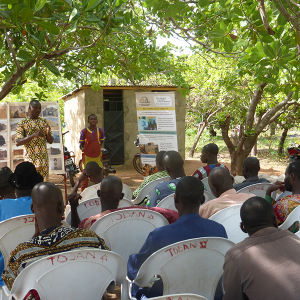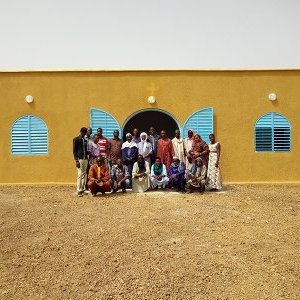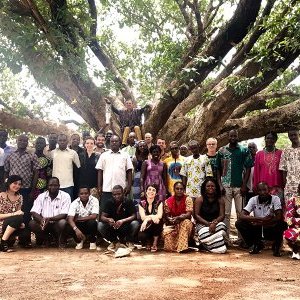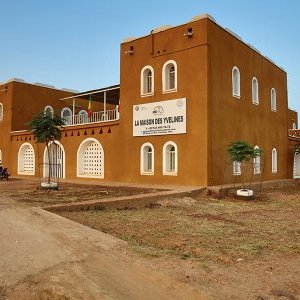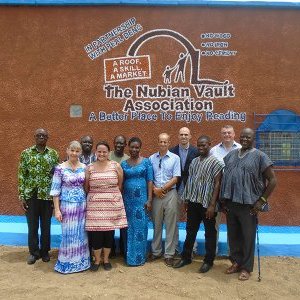Emergence and Growth of an Adapted and Resilient Housing Market by and for the inhabitants of Burkina Faso’s Northern Region
Since 2000, La Voûte Nubienne (The Nubien Vault) is an association which has been tackling the triple challenge of housing for as many as possible (adapted construction sector), rural economic development, and climate change adaptation and mitigation.
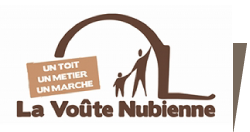
Overview of the project
Context: The disappearance of wood resources used in traditional Sahelian architecture and the inadequacy of imported modern building materials, mainly sheet metal and cement, leads to a lack of decent housing in the Sahelian regions, plunging millions of families into a vicious circle of poverty and discomfort, reinforcing their vulnerability. Faced with this context of unsuitable sheet metal roofs and unhealthy housing, Nubian vault (NV) constructions provide better living conditions for the greatest number of people and are a relevant technical alternative to respond to climate change and accompanying extreme weather events.
More specifically, in Burkina Faso’s Northern region three types of habitats are found side by side; traditional, modern and mixed. On the whole, one distinguishes between housing made of cement blocks and banco (mud bricks). Banco and straw terrace roofs are the most numerous, especially in rural areas, followed by sheet metal roofs, and finally slab and tile roofs. In this region, only the cities of Ouahigouya and Yako have urban development master plan schemes provided by the Ministry of Housing and Urban Planning. Faced with this state of affairs, the State has envisioned a policy of assistance to households in their construction efforts, as self-construction is proving to be an adequate alternative to the thorny lack of decent housing issue.
In terms of the various poverty indices, the Northern region remains one of the poorest in Burkina Faso. In 2009, 64.6% of the regional population lived below the poverty line. The situation worsened in 2014, when the rate rose to 70.4%. This situation has forced the migration of many people, mainly to Mali or Ivory Coast, and within Burkina Faso seasonally.
According to the Northern region’s 2018-2022 Development Plan, the region’s youth are facing numerous difficulties, principally: unemployment and underemployment, insufficient technical and vocational training, and the lack of a monitoring mechanism for young people’s integration into self-employment.
Specific collaboration framework: Following a collaboration of several years between AKNGS (Naam Union of Gomponsom, Yako province), twelve other Naam unions asked to collaborate with the Association La Voüte Nubienne (AVN). The National Federation of Naam Groups (NFNG) has been involved to accompany this dynamic collaboration. In July 2017, an agreement between AVN, NFNG and twelve of its Naam unions was signed. Then, in April 2018, an amendment was signed allowing two additional Naam unions to join the agreement.
The wish shown by NFNG and AVN is to allow, over time, a maximum of Naam unions to join this dynamic collaboration. Since then, a deployment program in Burkina Faso’s Northern region is being put in place, through several initiatives and thanks to various donors.
The NFNG has created a Support Unit/Adapted Habitat/Renewable Energy (SU-AH-RE) in charge of supporting the deployment of the market in the unions’ territories. Each of the fifteen unions mobilized have, for their part, created an Adapted Housing Commission, assigning a focal point and appointing a deputy to be in charge of the commission. In this perspective, AVN is also working with a microfinance institute (UBETEC) , and with an agricultural storage and sales cooperative, Viim Baoré, both under the umbrella of the NFNG.
Overall objective of the initiative:
In partnership with NFNG, UBETEC, Viim Baoré, and fifteen Naam unions under agreement, deploy the AVN methodology in fifteen communes in Burkina Faso (Northern region) to stimulate the propagation of an adapted and resilient housing market.
Specific objectives of the initiative:
Component 1: AVN operator partners (SU-AH-RE of NFNG, fifteen Naam unions) are trained and supported in the deployment of a methodology for emergence and growth of the VN market and in their ability to mobilize other stakeholders in their territories.
Component 2: At the communal level, the mobilization of local learners in a dual technical and entrepreneurial training program (on construction sites and in academic modules) allows the emergence of an adapted construction sector. Exogeneous VN craftsmen and their teams (comprised of 3 people) produce subsidized exemplary buildings meeting the first customers’ expectations, benefitting from an incentive, all the while continuing their training courses.
Component 3: Private and public VN demand is stimulated (awareness raising, subsidies and incentives) in order to enable the emergence and rapid growth of the market, the exemplary nature of the constructed buildings and the strengthening of the employability of the players in the sector.
AVN’s 20 years of experience, in five countries and more than fifteen regions, have enabled it to build and test an efficient and easily duplicated field methodology. Increasing results, international recognition and the emergence of a network of mobilized local partners, who can be mobilized in the deployment of this methodology, make the expected scaling of the AVN program possible. (www.lavoutenubienne.org/-resultats-et-impacts- )
Deploying the Association La Voûte Nubienne (AVN) methodology in fifteen communes in Burkina Faso (Northern region) to stimulate the propagation of an adapted and resilient housing market.
Ongoing research
Component 1 result: The coordinators, focal points and deputies of the operator partners (SU-AH-RE of NFNG, fifteen Naam unions) are trained in the AVN methodology of territorial deployment and are thus able to start its implementation. AVN accompanies its partners in their implementation actions and continues the production and evolution of these different tools. Stakeholders (institutional actors, civil society, other development operators, etc.) are made aware of the VN concept and its market deployment.
Measure of results: Number of methodological transfer tools and supports produced and/or improved, number of training modules offered to partner operators, and number of information and awareness meetings offered to stakeholders.
Component 2 result: All the conventional construction players are made aware of the project to deploy a new housing market in the fifteen municipalities and they are offered a technical and entrepreneurial program. Among the most motivated, a selection is made and they formalize their interest in joining the training program.
Measure of results: Number of awareness-raising meetings held, number of learners contracted, number of training modules completed and number of open evaluation tools (learner path booklet).
Component 3 result: At the regional and municipal levels, actions to raise the awareness of customers and constructors are carried out. In the two communes, several exemplary residential buildings (four per commune) are financed and built for particularly vulnerable individuals or families, chosen collectively by the local operators. Then financial incentives are offered (incentives + distribution/control = 350€) to the first private customers for access to a housing in VN. Adapted and resilient houses are built for and by the families of the first customers and those of the learners.
Measure of results: Number of control buildings built, number of financial incentives distributed, and number of buildings constructed.
- A gain in the quality of life and comfort (good thermal and hygrometric performance, resistance to extreme weather events, etc.) for families who have chosen VN construction, in an adapted and resilient construction rationale in the Sahelian environment.
- Training and employability of young farmers in a labour-intensive green sector during the agricultural off-season (dry season).
- Strengthening agricultural, familial, national and local economies by re-injecting construction costs (materials and labour) into local economic circuits.
- Mobilization and training of local operator partners in the deployment of the market allowing, moreover, the reinforcement of their general skills.
- Positive impacts on the climate and the environment (adaptation and mitigation) with a reduction in greenhouse gas emissions (construction and use phases) and the mitigation of deforestation and desertification in the Sahel.
The project is co-financed by the AFD (Agence Française de Developpement/ French Development Agency) , SOS Faim, the Polish Government and AVN's own funds.
organisation
Created under French law in 2000 by Thomas Granier, a French mason, and Séri Youlou, a Burkinabe peasant, the association has since been addressing the tripe challenge of housing for as many as possible (adapted construction sector), rural economic development, and climate change adaptation and mitigation.
AVN is present in five countries (Burkina Faso, Mali, Benin, Ghana and Senegal) where its presence has enabled the implementation of approximately 3500 construction sites in more than 1000 localities and the training of nearly 1000 craftsmen and Nubien Vault apprentices.
The methodology, proposed by AVN, for deploying the adapted housing market benefits from clear interest of all its stakeholders (communities, masons, customers, contractors, etc.) and international recognition, in particular the United Nations agencies (UN-Habitat supports AVN’s program). This methodology is easily assimilated and duplicated by AVN’s local operating partners: cooperatives, civil society organizations, smallholder organizations, community based organizations including women’s groups, NGO, etc. AVN managers come from the target regions and transfer their know-how to the field partners.
in collaboration



